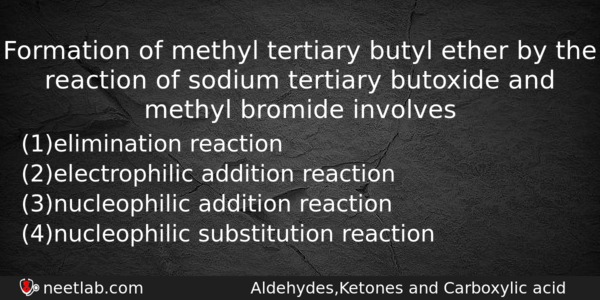| ⇦ | 
| ⇨ |
Formation of methyl tertiary butyl ether by the reaction of sodium tertiary butoxide and methyl bromide involves
Options
(a) elimination reaction
(b) electrophilic addition reaction
(c) nucleophilic addition reaction
(d) nucleophilic substitution reaction
Correct Answer:
nucleophilic substitution reaction
Explanation:
The formation of methyl tertiary-butyl ether by the reaction of sodium tertiary butoxide and methyl bromide involves of nucleophilic substitution (S(N)2) reaction of alkyl halides in which halogen is replaced by alkoxy group.
Related Questions: - The solubility product of a sparingly soluble salt AB at room temperature
- Which one of the following ions has electronic configuration[Ar] 3d⁶?
- Carbon percentage is maximum in
- Which of the following sets of quantum numbers violates the rules of quantum mechanics
- An example for a saturated fatty acid, present in nature is
Topics: Aldehydes Ketones and Carboxylic Acid
(89)
Subject: Chemistry
(2512)
Important MCQs Based on Medical Entrance Examinations To Improve Your NEET Score
- The solubility product of a sparingly soluble salt AB at room temperature
- Which one of the following ions has electronic configuration[Ar] 3d⁶?
- Carbon percentage is maximum in
- Which of the following sets of quantum numbers violates the rules of quantum mechanics
- An example for a saturated fatty acid, present in nature is
Topics: Aldehydes Ketones and Carboxylic Acid (89)
Subject: Chemistry (2512)
Important MCQs Based on Medical Entrance Examinations To Improve Your NEET Score
18000+ students are using NEETLab to improve their score. What about you?
Solve Previous Year MCQs, Mock Tests, Topicwise Practice Tests, Identify Weak Topics, Formula Flash cards and much more is available in NEETLab Android App to improve your NEET score.
Share this page with your friends

Leave a Reply